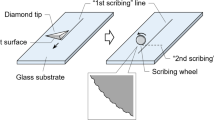Abstract
Surface roughness is one of the crucial factors in silicon fusion bonding. Due to the enhanced surface roughness, it is almost impossible to bond wafers after KOH etching. This also applies when wafers are heavily doped, have a thick LPCVD silicon nitride layer on top or have a LPCVD polysilicon layer of poor quality. It has been demonstrated that these wafers bond spontaneously after a very brief chemical mechanical polishing step. An adhesion parameter, that comprises of both the mechanical and chemical properties of the surface, is introduced when discussing the influence of surface roughness on the bondability. Fusion bonding, combined with a polishing technique, will broaden the applications of bonding techniques in silicon micromachining.
Similar content being viewed by others
Author information
Authors and Affiliations
Additional information
Received 30 October 1996/Accepted: 14 November 1996
Rights and permissions
About this article
Cite this article
Gui, C., Albers, H., Gardeniers, J. et al. Fusion bonding of rough surfaces with polishing technique for silicon micromachining. Microsystem Technologies 3, 122–128 (1997). https://doi.org/10.1007/s005420050068
Issue Date:
DOI: https://doi.org/10.1007/s005420050068




